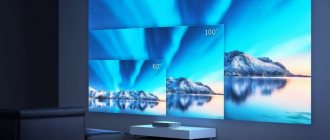AMOLED (Active Matrix Organic Light-Emitting Diode) display technology for smartphones is highly popular.
The use of organic LEDs as light-emitting elements makes it possible to see a bright and high-contrast picture. At the same time, the operation of the active matrix allows you to separately control each transistor responsible for the color representation of the pixel. About 10 years ago, Samsung began creating its own types of screens using Super AMOLED technology, which, as you might guess, is an improved version of AMOLED. How are they different?
Content:
- 1 Features of the technology 1.1 What are the features of Super Amoled
- 6.1 What technology has given to mobile devices
Super Amoled technology is a new method of producing TV matrices, which was developed by Samsung. The term has become widespread due to advertising campaigns of the brand, which is actively promoting its equipment with this creation technology. Other manufacturers often prefer LCD IPS matrices. Let's take a closer look at what an Amoled display is, and whether it is really better than classic options from other brands.
Features of the technology
In 2010, Samsung developed a new matrix based on LEDs. There is no air gap under the Touch Screen. The touch layer is located directly on the display. And due to this, brightness and contrast have improved. At the same time, energy consumption has decreased. New TVs have begun to resemble modern smartphones in screen type. Additionally, this technology made it possible to avoid the risk of dust getting on the matrix and causing glare.
Despite the fact that this technology has become widespread and is used to create not only TV, but also mobile touch phones, only Samsung continued to use the term Amoled.
What are the features of Super Amoled
Super displays differ from classic Amoled matrices. They are built according to a completely different type, unlike LCD TVs. Super Amoled uses mini-LEDs instead of liquid crystals in its pixels. They have the same filters as LCD crystals, but they themselves emit light. Their brightness changes depending on the power of the supplied current using pulse width modulation (PWM) techniques.
The new approach made it possible to get away from auxiliary lighting and a mirror-reflective substrate. As a result, the thickness of the matrix became smaller, as did power consumption.
Let us remind you that LCD or LCD TVs operate using liquid crystals, diode backlighting and a special mirror substrate. The light emitter is located behind the crystals. It transmits it through a liquid that partially absorbs the light. Depending on the position and number of crystals, the brightness becomes more or less. In this case, the radiation comes in only three colors: red, green, blue. Their combination changes the shades of the picture on the screen.
It turns out that Super Amoled displays provide better image quality, contrast and brightness. Due to the absence of an air cushion and the use of LEDs instead of liquid crystals.
AMOLED screen design
Under the abbreviation AMOLED lies the decoding of “Active Matrix Organic Light-Emitting Diode”. This means that this matrix is built on the basis of organic light-emitting diodes, while it is active. Each pixel here lights up independently, as a result of which a separate backlit layer is not required - this reduces the thickness of the panel and also reduces power consumption.
Almost any AMOLED screen has the following structure:
- The top layer is cathode ;
- Below is an organic layer with LEDs - there is no air gap;
- Even lower is a matrix of thin-film transistors that control diodes;
- Next comes the anode layer ;
- All this lies on a substrate made of silicone, metal or some other material .
Structure of an AMOLED screen
The order of LED subpixels in AMOLED displays can be different. Samsung has long used PenTile - a checkerboard pattern (blue in the middle, two green on the sides, two red behind them). It is this position of the subpixels that has the most positive effect on power consumption.
PenTile - subpixel order used by Samsung
Advantages of Samsung technology
Super Amoled displays have surpassed LCD options in quality. They also require careful handling, but have the following advantages:
- Small screen thickness. The elimination of the substrate, scattering and light-absorbing filters from the design made the screens thinner than their LED counterparts. This is also facilitated by the presence of a sensor installed without, albeit a small, air gap.
- Reduced energy costs. An important criterion in the current conditions of rising prices for housing and communal services. This was achieved through LEDs that regulate brightness themselves, rather than using individual pixels and light sources.
- Pure and rich black color. In liquid crystal screens, the black tint was obtained by rotating the position of the liquid crystals so as not to allow white backlight light to pass through. But some of the light from the radiation source still leaked through. And in the end, instead of pure black, the result was dark gray, blue or brown. Amoled technology has managed to completely avoid this. The pixel simply turns off when dimming is needed. There is no brightness in black, so this option with turning it off became optimal.
- Ability to adjust brightness and high contrast. New displays are able to regulate the supplied power, thereby increasing or decreasing the set parameters. With a completely white screen, the contrast is high - about 400 cd/m². When there are a lot of dark shades in the picture, the light areas become visually brighter. This improves image quality. Top IPS TVs have brightness levels up to 1000 cd/m².
- Curvature of the screen. New Amoled displays can be not only flat, but also semicircular. This option is not available for LCD TV. The pixels are arranged in such a way that it is impossible to change the design.
Important! All of the above advantages apply to Super Amoled. The simple version of the new product has the same advantages, except for brightness. Its settings are not as impressive as in the updated Super technology.
Main advantages of AMOLED panels
The physical properties of matrices consisting of organic light-emitting diodes are such that the screen can have a tiny thickness . In particular, this is especially important for smart watches and fitness bracelets, the physical dimensions of which should not be large.
But the most important advantage of any OLED screen (including its AMOLED variations) is low power consumption . Each pixel of such a display glows independently. It turns out that the greatest energy consumption will be at the moment when the entire screen displays a flat white color. And if some areas need to display dark colors, they glow noticeably dimmer, which reduces battery consumption.
The darker the picture displayed on the display, the less energy is consumed.
High contrast is another undoubted advantage of such screens. This is explained by the same ability of pixels to glow on their own. For example, under the IPS panel there is a substrate of LEDs that illuminate black colors as well. This doesn't happen here.
Differences in contrast are immediately noticeable
It is also due to this that the picture on the AMOLED screen is clearly visible even under bright sunlight . IPS technology allows you to see something on the display on a clear day only by turning down the backlight brightness, which leads to a sharp increase in power consumption.
Disadvantages of Super Amoled
Like any development or new technology, Super Amoled is not without its drawbacks. The disadvantages include:
- High price. A large panel with LED radiation is more expensive than the TOP LCD IPS model. At the same time, in the budget segment you can find a Samsung version with better characteristics than an LCD version of the same price.
- Tendency to fade. Small LEDs provided high contrast and brightness, but were more prone to fading in the sun. Their resource is limited. Moreover, the speed of darkening depends on movie preferences. For example, if you watch fast-paced scenes, the brightness will decrease over time. And when viewing static information, where there is more white color, the LEDs may darken.
- The appearance of flickering PWM diodes. The average flicker is from 60 to 100 Hertz. People with sensitive eyes may notice this. So, if you watch for a long time, discomfort will appear. But this defect can be slightly changed. It is enough to lower the brightness below 100% to reduce eye strain.
- Pentile is a matrix structure that involves the use of a smaller number of classic blue subpixels. As a result, the display only uses 5 rather than 6 subpixel options. This minus is not noticeable when watching TV shows, although a person who constantly works with TV will notice the lack of shades.
All the shortcomings of the Super Amoled screen, except for the price, are almost invisible. But the picture quality, display thickness and reduced power consumption are felt immediately after purchase.
Minuses
On the plus side, the screen's energy consumption depends on the brightness setting, meaning more battery power is needed to display bright colors. The next disadvantage is the fragility of the internal connections of the screen. With slight mechanical damage, it fails, and with a slight loss of tightness, it will quickly lose color and break.
Shorter service life is a disadvantage. The service life is especially reduced when displaying bright colors - subpixels burn out at different rates, and this leads to a violation of color rendition. Literally 3-4 years ago, the disadvantages included the high price of creating AMOLED panels, but today the cost of production is equal to the cost of creating IPS matrices or even lower.
Prospects for technology development
Modern Amoled screens are equipped not only with Samsung TVs, but also with tablets, mobile phones, and smartphones. In the TV itself, the technology has been slightly changed. And it is usually called LED or Super Amoled matrix. And this is not surprising, because the depth of color amazes users.
Initially, such matrices were developed for smartphones. High contrast and fast touch screen response are big advantages for gadgets. But Super Amoled has become widely used to create TV.
According to experts, the cost of new TVs will not fall in the next 5-10 years. At the same time, the demand for equipment will grow. The development is confirmed by the fact that Apple plans to launch new smartphones with new Amoled screens.
The Samsung developer himself does not plan to abandon the new technology. This is confirmed by the increase in the number of new TVs with Super Amoled screens. They belong to the premium segment of household appliances for the home.
conclusions
Before making a final choice in favor of one technology or another, try using a smartphone with an OLED display at a brightness below 50%. If after a couple of hours of use you don't want to smash your smartphone against the wall, most likely you should opt for OLED.
The main reason why users choose IPS is the lack of PWM. But if your eyes are flicker-sensitive, an OLED screen will only be a pleasure. It outperforms IPS in terms of backlight uniformity, can display truly deep blacks, offers excellent energy efficiency and the Always On-Display function, which is useful in all respects. As for display burn-in, it almost never occurs in modern OLEDs.
Amoled technology in smartphones
Despite the presence of shortcomings, Amoled technology is actively occupying a confident position in the market of new smartphones. More and more manufacturers are installing Amoled displays instead of IPS displays. In addition to Samsung, this screen option is already found in devices from Xiaomi, Apple, Honor and other manufacturers.
What technology has given to mobile devices
Features of the new screens: perfect black color, maximum brightness and absolute contrast. Some users criticize the displays for being too bright, but this is considered an advantage. Thanks to this option, the readability of text and pictures in the sun is much higher than in smartphones with IPS.
Another important achievement of Amoled technology is the reduction in display response time. It is only 0.1 ms. For a person this is an instant reaction. Whereas in IPS variants the duration of the touch response is about 5 ms. This is also not enough, but during dynamic games on a smartphone the difference will be noticeable.
Flaws
The downside of the screen is that it does not display perfect white. Shades fall into the blue or green part of the spectrum. But the color shift was and always is. Ideal color rendition does not yet exist on displays of any quality.
The main disadvantage is flicker or PWM. It is available in any display, including IPS. In Amoled technology, PWM becomes noticeable when the brightness is reduced to 5-20% or to half. This effect cannot be noticed by the eye, but it is harmful to vision. Correctly adjusting the display brightness will help reduce this deficiency. It is enough not to lower it below 70-75%.
Important. Regarding the short service life of the display, the disadvantage is a myth. According to test data, even after 2 years of active use of the smartphone, the picture quality does not deteriorate.
Three models of smartphones with Amoled display
- Apple iPhone XS Max. This is a modern device with an A12 Bionic processor. Amoled screen diagonal 6.5 inches. There are two main cameras with 12 MP and one front camera with 7 MP.
- Xiaomi Mi Mix 3 with a new display diagonal of 6.39 inches. Matrix resolution 2340 x 1080p. There are also three cameras: two main ones of 12 MP and one front one of 24 MP. Powered by an eight-core processor.
- Huawei Honor Magic 2 with Kirin processor Screen diagonal – 6.39 inches, resolution 2340 x 1080 p. Display proportions 19.5:9, PPI 403. Operating system Android 9.0 (Pie).
From Samsung, which has introduced new technology, the most popular smartphone with an Amoled screen is the Galaxy A9, 2022. Its display diagonal is 6.3 inches, resolution 2220 by 1080 r.
Most experts believe that Amoled is the future. And that soon most new devices will be equipped with these very screens. And after them, flat-screen TVs will follow.
Found a mistake? Select it and press ctrl+enter
- 40
Comparison with IPS
IPS screens cannot boast of absolute black color and exorbitant contrast, but they have a number of advantages: they do not fade, are more affordable, and convey accurate colors without excesses (in this regard, AMOLED sometimes oversaturates and artificially turns up bright colors). If you take two phones: one with an IPS screen and the other with an AMOLED screen, then the average user simply will not notice the difference between them.
At the moment, a high-quality IPS display is visually no different from a Super AMOLED matrix. It’s just that the latter consumes less battery power, and this is its advantage. Therefore, certain manufacturers (including Apple) are gradually switching to using these technologies in their smartphones.
Please rate the article:
Join on Telegram











